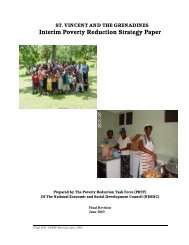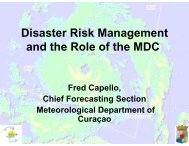The Anatomy of A Silent Crisis The Anatomy of A Silent Crisis
The Anatomy of A Silent Crisis The Anatomy of A Silent Crisis
The Anatomy of A Silent Crisis The Anatomy of A Silent Crisis
- TAGS
- anatomy
- www.bb.undp.org
You also want an ePaper? Increase the reach of your titles
YUMPU automatically turns print PDFs into web optimized ePapers that Google loves.
A global challenge — Goals missed<br />
Cost <strong>of</strong> humanitarian relief is expected to grow exponentially in the next 20 years<br />
Climate change also threatens the ability <strong>of</strong> the international community to deliver humanitarian<br />
relief. <strong>The</strong> financial requirements for humanitarian assistance are projected to increase by up to<br />
1600 percent over the next 20 years, in large part due to climate change. 28 Already today, the funds<br />
available for disaster preparedness and disaster relief are inadequate. Bilateral funds for disaster relief<br />
amount to less than $10 billion per year, 220 leaving many disasters with little or no support.<br />
Only a very small proportion <strong>of</strong> global humanitarian assistance goes into disaster preparedness<br />
even though this is a crucial and worthwhile investment. Some experts estimate that for every dollar<br />
invested in disaster preparedness, six dollars could be saved in reconstruction costs. 221 Ultimately,<br />
the ability <strong>of</strong> individual households to protect themselves against the physical and economic shocks<br />
<strong>of</strong> disaster is the best way to assure survival.<br />
Costs <strong>of</strong> adaptation to climate change<br />
Climate adaptation refers to individual or governmental action to reduce present adverse effects<br />
or future risks <strong>of</strong> climate change. This activity will be critical to coping with the human impact <strong>of</strong><br />
climate change in the future. However, to date, investments have been very limited.<br />
Many new plans and adaptation projects in developed countries<br />
Many developed nations have already realized that ignoring climate change is too costly<br />
and is taking action by means <strong>of</strong> insurance solutions and state funding. Here are some recent<br />
prominent examples:<br />
• <strong>The</strong> Netherlands has an overall budget <strong>of</strong> $3 billion to protect against flooding. 36<br />
• Australia is investing more than $13 billion222 to counter the impact <strong>of</strong> climate change. 223<br />
• <strong>The</strong> UK government is discussing whether to invest $42 billion to upgrade the Thames Flood<br />
Barrier to protect London from rising sea levels. 223<br />
• On the US California coastline, a $14 billion investment topped up with annual maintenance fees<br />
<strong>of</strong> $1.5 billion is suggested to combat climate change related to sea level rise and increased<br />
storms to shore up levees and build sea walls. 215<br />
Adaptation needs to be scaled up 100 times to avert worst outcomes<br />
Developing nations have also realized the enormity <strong>of</strong> the climate change challenge, but the<br />
commitments to invest funds in climate adaptation in developing countries amount to very little. <strong>The</strong><br />
multilateral funds that have been pledged for climate change adaptation across developing countries<br />
currently amount to about $400 million. 226 This amount is less than the German state <strong>of</strong> Baden-<br />
Württemberg is planning to spend on strengthening flood defense. 36 <strong>The</strong> funds needed for adaptation<br />
in developing countries stand in sharp contrast to this current level <strong>of</strong> commitment. Experts and aid<br />
agencies estimate that the true cost <strong>of</strong> adaptation in developing countries ranges from $4 to $86 billion<br />
annually225 with an average <strong>of</strong> $32 billion annually. 36,52 <strong>The</strong> African Group, comprising more than 50<br />
69







